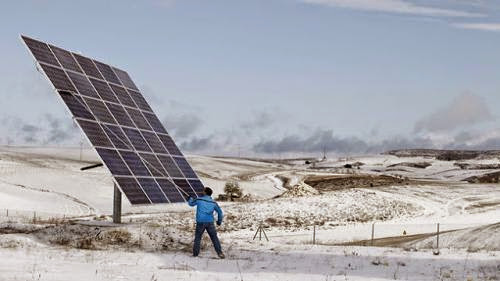IPP will be setting up 8660 MW solar ">o To work towards Narendra Modiji's vision of Green India
o Welspun Renewables will be executing over 1 GW projects well within this calendar year - 2015
Mumbai, Feb 14, 2015 Welspun Renewables, India's leading renewable energy generator has pledged to set up mega 11 GW solar and wind projects across the country. In line with supporting Prime Minister Narendra Modi's vision of 100 GW, Welspun Renewables will be formally announcing this commitment in the presence of Honorable Shri Modiji and other prominent global and national policymakers. The 11001 MW capacity will be developed as 8660 MW of solar and 2341 MW of wind power projects.
The announcement would be made on the first day of RE-INVEST at Vigyan Bhawan in New Delhi. RE-INVEST is Ministry of New ">Mr. Vineet Mittal, Vice Chairman Welspun Renewables said, "We believe in Honorable Prime Minister Modi's vision and are committed to doing our utmost in exponentially increasing India's green energy capacities. Under the aegis of Shri Modiji India has emerged as one of the most conducive regions for renewable energy development. Our 11001 MW commitment is a direct reflection of how the solar and wind energy industries will be growing in the future. We would like to thank both the MNRE and the state governments for giving us their support in developing our current and previous projects."
Welspun Renewables will be commissioning over 1 GW of solar and wind capacities well within this calendar year - December 2015. In recent months Welspun Renewables has signed renewable energy agreements of 1100 MW with Gujarat and 100 MW PPA with Andhra Pradesh. The organization envisions developing power projects pan India, with existing projects located in other high radiation zones like Gujarat, Rajasthan, Madhya Pradesh, Maharashtra, Karnataka, Andhra Pradesh, Tamil Nadu and Punjab.
Reference: altenergyprograms.blogspot.com
Dec 14, 2010Pam Eaton
Photo courtesy of the Bureau of Land Management
Just before Thanksgiving, Interior Secretary Ken Salazar and Deputy Secretary David Hayes each talked about "wise" and "smart" planning for development of our nation's renewable energy resources. Their comments were about a new program for off-shore wind in the Atlantic, but they could have just as easily been talking about on-shore wind and solar development. Now the Department of the Interior, in cooperation with the Department of Energy, has released its draft plan for a solar energy program on our nation's public lands, and we will see the first attempt to be "wise with our planning."
READ MORE IN OUR RENEWABLE ENERGY SERIES:
* Technology will drive America's race to a clean energy future
* Renewable energy on our public lands: Let's get it right
* Shaping Renewable Energy: How we can minimize the environmental impacts
* Guiding solar to the best places
* Using biology and science to guide development
* Technology will drive America's race to a clean energy future
The new plan, known as the Solar Programmatic Environmental Impact Statement (PEIS), will be the blueprint for the federal government's approach to solar energy development across the west. A good blueprint for a solar program on public land will help renewable energy grow and develop while minimizing costs--to the environment, rate payers, and us taxpayers, as owners of the public lands.
What we are looking for in a blueprint for a renewable energy program on public lands are:
A MEANS TO GUIDE DEVELOPMENT TO THE MOST APPROPRIATE PLACES. Under Secretary Salazar's leadership, the BLM has, for the first time, begun to take hard look for places appropriate for renewable energy development. It has studied 24 areas in Arizona, California, Colorado, New Mexico, Nevada, and Utah with great solar resources, close to existing roads and transmission lines, and with limited conflicts with wildlife, wildlands, and other uses and is beginning to look for additional appropriate areas. But identifying good areas is not enough, the blueprint must lay out how BLM will guide development into those zones.
A MEANS TO ENSURE THAT APPROPRIATE RENEWABLE ENERGY RESOURCES GET BUILT. The failure of previous administrations to plan for a world in which clean, reliable energy powers our lives has led to speculators "staking claims" in the form of renewable energy applications on vast areas of public lands. These pre-existing claims tie up good sites or distract attention from focusing permitting in the most appropriate areas. The blueprint needs to be clear about how this back log of speculative claims scattered across the landscape will be cleared so that good projects in appropriate areas can move forward.
A MEANS TO ENSURE EARLY AND APPROPRIATE ENVIRONMENTAL REVIEW. Over the last year, as BLM has processed permits for solar energy projects in California, it has learned a lot about how to conduct good, scientifically and legally sufficient environmental reviews for large-scale solar projects. Those lessons need to be part of blueprint for doing it better in the future.
A MEANS TO ENSURE THAT THE PUBLIC'S INTERESTS--IN WILDLIFE, WILDLANDS, AND IN FAIR RETURN FOR USE OF OUR PUBLIC LANDS--ARE PROTECTED. The public lands have valuable renewable energy resources that can play a part in reducing pollution and our contribution to climate change, but those lands have other important resources too. A renewable energy program on our public lands must address those other values--by guiding development away from areas with important wildlife habitat, wildness, scenic beauty, cultural resources and other important resources public lands provide and ensuring that when projects are built on public lands there is fair return for the use of the public's land and resources and there is meaningful mitigation for unavoidable impacts.
The draft PEIS will take us one step closer to designing a solid national renewable energy siting program. These efforts could serve as a model for how smart energy production can occur on public lands by ensuring that projects tread lightly on the landscape, are permitted in a timely manner, undergo an efficient environmental review, and offer a fair return to taxpayers--all critical components of smart energy policy.
Chris Huhne has finally announced much-awaited details of the Renewable Heat Incentive (RHI) scheme.
It covers such technologies as solar water heating, using wood, wood pellets and woodchips, air and ground source heat pumps, energy from waste, on-site biogas, deep geothermal and injection of biomethane into the grid.
36% of the UK's overall energy is used for heat, creating 175 million tonnes of carbon emissions a year.
The industry had originally hoped that the scheme would start at the same time as the Feed-In Tariffs for renewable electricity a year ago, then it was expected this April, but now payments won't be be available to households until October 2012.
The scheme has become a victim of government cuts and will be smaller in size than originally thought and introduced in phases.
Importantly, because of criticism of the potential impact on fuel bills, the RHI will not be funded by an RHI levy but from general Government spending.
As a result, it will be introduced in two phases. In phase 1, more than a quarter of the first year's budget, around lb15 million, is to be guaranteed up to 25,000 household installations through a premium payment scheme.
Phase 1 will focus on people living off the gas grid, who typically spend more on their heating and whose fuels, like coal, have a higher carbon content.
Participants will then provide feedback on how the scheme works to help design the second phase.
In this phase, coinciding with the introduction of the Green Deal, the scheme will expand so that by 2020 there will be an estimated 13,000 installations in industry, 110,000 in the commercial and public sector supply 25% of this sector is demand, and creating 150,000 jobs.
CARBON SAVINGS AND AIR POLLUTION
It is hoped that the scheme will help deliver 44 million tonnes of carbon dioxide savings by 2020, though 8 million of these are already accounted for by the European Emissions Trading Scheme. Those emissions within the emissions trading scheme will cost lb35/tCO2 and those outside the scheme a further lb12 per tonne.
However, there are concerns about the impact on air quality of a lot of new biomass combustion, particularly from particulates such as PM10. The final RHI proposals could lead to 28TWh of biomass burned. and assessment by Defra of the proposals shows that this could lead to up to lb2.6 billion of potential lifetime social cost.
This is a staggering amount.
THE TARIFFS
The highest tariffs will be paid to solar thermal water heating (8.5p/kWh) small biomass schemes (7.6p/kWh or 1.9p/kWh - see below why), and biomethane (6.5p/kWh). Small ground source heat pump schemes will receive 4.3p/kWh, and large schemes 3p/kWh.
Municipal solid waste schemes including Combined Heat and Power (CHP) will receive 4.7p/kWh or 1.9p/kWh, depending on which tier they are in, and large biomass schemes 2.6p/kWh.
Solar water heating was by far the most popular renewable energy technology under the previous renewable energy subsidy schemes like Clear Skies. It works very well in the UK and can supply between 40 and 50% of domestic hot water requirements, so it is good that it receives the most support.
Because of doubts about their efficiency air source heat pumps will not be eligible at the start of the RHI. Nor will heat pumps that deliver the heat to air as opposed to water. Some will consider this unfair, but it is to do with the difficulty of metering this kind of heat.
Heat meters will need to be installed at the point of generation and, where appropriate, at the point of usage in order to claim payments.
Bioliquids also will not be eligible from the start because of the complexity of the market and their uses in transport etc. They can also have a high energy density.
RHI support will only be available if the installation in question has not received (and will not receive) any other public funding.
The tariffs will be paid for 20 years to the eligible technologies that have been installed since July 15, 2009 with payments for each kilowatt of renewable heat produced.
Payments, which will be administered by Ofgem, are to be claimed by, and paid to, the owner of the heat installation or the producer.
These payments will be fixed for the lifetime of the scheme, once a measure is installed, adjusted in line with inflation. But the levels of support available for new entrants as time goes on may decrease.
REWARDS LINKED TO ENERGY CONSERVATION
Following criticism that there might be no requirement that the building in question has an efficient fabric, by being introduced with the Green Deal, homes must be insulated to reduce demand, as with earlier schemes, such as the Low Carbon Building Programme, because everyone knows is more cost efficient to save energy than to generate it.
There has been a worry about what happens when some smart meters enter into the market. When buildings are metered on a half hourly basis energy the incentive will be to run your equipment as much as possible because the more your meter ticks over, the more money you make.
This has to some extent been met by introducing a two-tier tariff system for biomass boilers to reduce incentive to over-generate. Upon reaching a prescribed level of heat generation, the tariff drops to a lower tier 2 tariff. For solar thermal, once the equipment is installed, the amount of heat generated is not controlled by the owner.
The RHI has been a long time coming. There are many in the industry raring to get installing, and there is a huge potential market. But most will have to wait a good while yet before they can take advantage of the scheme.






















